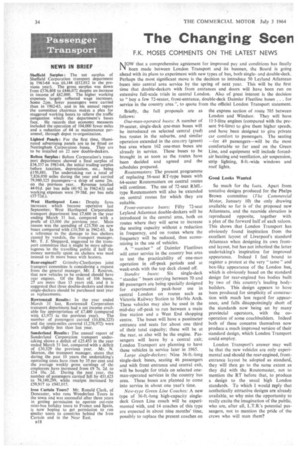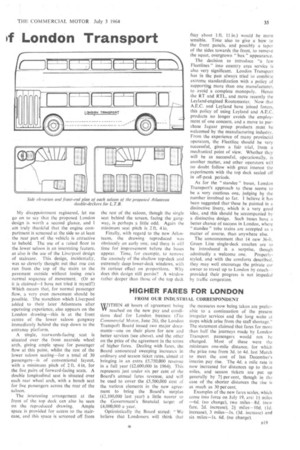The Changing Scen If London Transport
Page 36

Page 37

If you've noticed an error in this article please click here to report it so we can fix it.
F.K. MOSES COMMENTS ON THE LATEST NEWS
'MOW that a comprehensive agreement for improved pay and conditions has finally been made between London Transport and its busmen, the Board is going ahead with its plans to experiment with new types of bus, both singleand double-deck. Perhaps the most significant move is the decision to introduce 50 Leyland Atlantean buses into central area service by the spring of next year. This will be the first time that double-deckers with front entrances and doors will have been run on extensive full-scale trials in central London. Also of great interest is the decision to "buy a few 72-seater, front-entrance, double-deck Daimler Fleetline buses . . for service in the country area ", to quote from the official London Transport statement.
Briefly, the full proposals are as follows: One-man-operated buses: A number of 39-seater, single-deck one-man buses will be introduced on selected central (red) bus routes in the suburbs, and similar operation extended in the cout.try (green) bus area where 162 one-man buses are already in service. These buses to be brought in as soon as the routes have been decided and agreed and the schedules prepared. Routemasters: The present programme of replacing 56-seat RT-type buses with 64-seater Routemasters on central routes will continue. The use of 72-seat RMLtype Routemasters will also be extended on central routes for which they are suitable.
Front-entrance buses: Fifty 72-seat Leyland Atlantean double-deckers will be introduced in the central area, both on routes where they will serve to increase the seating capacity without a reduction in frequency, and on routes where the frequency will be reduced, thus economizing in the use of vehicles. A " number" of Daimler Fleetlines will enter service in the country bus area to test the practicability of one-man operation in off-peak periods and at week-ends with the top deck closed off.
Standee buses: Six single-deck " standee " buses carrying between 70 and 80 passengers are being specially designed for experimental peak-hour use in central London on routes such as Victoria Railway Station to Marble Arch. These vehicles may also be used in the mid-day off-peak to run between a main line station and a West End shopping centre. The buses will have a passimeter entrance and seats for about one third of their total capacity; these will be at the rear, as also will be the engine. Passengers will leave by a central exit; London Transport are planning to have these vehicles in service later in 1965.
Large single-deckers: Nine 36-ft.-long single-deck buses, seating 46 passengers and with front entrance and central exit, will be bought for trials on selected oneman-operated services in the country bus area. These buses are planned to come into service in about one year's time.
New-type Green Line Coaches: A new type of 36-ft.-long high-capacity singledeck Green Line coach will be experimented with, and 14 coaches of this type are expected in about nine months' time, possibly to replace the present coaches on the express section of route 705 between London and Windsor. They will have 11-3-litre engines (compared with the present 9.6-litre) to give them higher speeds, and have been designed to give private car comfort to passengers. The seating —for 49 passengers—will be the most comfortable so far used on the Green Line, and equipment will include forcedair heating and ventilation, air suspension, strip lighting, 8-ft.-wide windows and roof lights.
Good Looks Wanted
So much for the facts. Apart from tentative designs produced for the Phelps Brown committee (The Commercial Motor, January 10) the only drawing available so far is of the proposed new Atlanteans, and the nearside elevation is reproduced opposite, together with a plan of the forward half of each saloon, This shows that London Transport has obviously found inspiration from the excellent layout of Liverpool's standard Atlantean when designing its own frontend layout, but has not inherited the latter undertaking's inspiration for improved appearance. Indeed I feel bound to register a protest at the very " tame " and box-like appearance of the London bus, which is obviously based on the standard design for rear-engined bus bodies built by two of this country's leading bodybuilders. This design appears to have been produced for simplicity of construction with much less regard for appearance, and falls disappointingly short of the standards now being set by many provincial operators, with the cooperation of some coachbufiders. Indeed both of these concerns themselves now produce a much improved version of their standard design, which London Transport could employ.
London Transport's answer may well be that the new vehicles are only experimental and should the rear-engined, frontentrance layout be adopted as standard, they will then go to the same extent as they did with the Routemaster, not to mention the RT before that, to produce a design to the usual high London standards. To which I would reply that aesthetically attractive designs are already available, so why miss the opportunity to really excite the imagination of the public, who are, after all, L.T.B.'s potential passengers, not to mention the pride of the crews who will man them?
My disappointment registered, let me go on to say that the proposed London design is worth a second glance, and 1 am truly thankful that the engine compartment is screened at the side so at least the rear part of the vehicle is attractive to behold. The use of a raised floor in the lower saloon is an interesting feature, as also is the use of the Liverpool design of staircase. This design, incidentally, was so cleverly thought out that one can run from the top of the stairs to the pavement outside without losing one's normal sequence of movement. (Or so it is claimed—I have not tried it myself!) Which means that, for normal passenger flow, a very even movement should be possible. The stanchion which Liverpool added to their later Atlanteans after operating experience, also appears on the London drawing—this is at the front centre of the lower saloon gangway immediately behind the step down to the entrance platform,
A single, rearwards-facing scat is situated over the front nearside wheel arch, giving ample space for passenger flow at this point, whilst the rest of the lower saloon seating—for a total of 30 passengers—is of conventional layout, with a minimum pitch of 2 ft. 4 in, for the five pairs of forward-facing seats. A double longitudinal seat is situated aver each rear wheel arch, with a bench seat for five passengers across the rear of the saloon.
• The interesting arrangement at the front of the top deck can also be seen on the reproduced drawing. Ample space is provided for access to the staircase, and this space is screened off from the rest of the saloon, though the single seat behind the screen, facing the gangway, is perhaps a little odd. Again the minimum seat pitch is 2 ft. 4 in, Finally, with regard to the new Allanteans, the drawing reproduced was obviously an early one, and there is still time for improvement before the buses appear. Time, for example, to remove the anomaly of the shallow top-deck and extremely deep lower-deck windows, with its curious effect on proportions. Why does this design still persist? A window rather deeper than those of the top deck (say about 1 ft. 11 in.) would be more sensible. Time also to give a bow to the front panels, and possibly a taper of the sides towards the front, to remove the squat, overgrown " box " appearance.
The decision to introduce "a few Fleetlines " into country area service is also very significant. LonclOn Transport has in the past always tried to combine extreme standardization with a policy of supportiqg more than one manufacturer, to avoid a complete monopoly. Hence the RT and RTL, and more recently the Leyland-engined Routemaster. Now that A.E.C. and Leyland have joined forces, this policy of using Leyland and A.E.C. products no longer avoids the employment of one concern, and a move to purchase Jaguar group products must be welcomed by the manufacturing industry. From the experience of many provincial operators, the Fleetline should be very successful, given a fair trial, from a mechanical point of view. Whether they will be as successful, operationally, is another matter, and other operators will no doubt follow with great interest the experiments with the top deck sealed off in off-peak periods.
As for the " standee " buses, London Transport's approach to these seems to be a very cautious one, judging by the number involved so far. I believe it has been suggested that-these be painted in a distinctive livery, which is a very good idea, and this should be accompanied by a distinctive design. Such buses have a better chance of success in London, where " standee " tube trains are accepted as a matter of course, than anywhere else.
The announcement that 14 new 36-ft. Green Line single-deck coaches are to be introduced is a surprise, though
admittedly a welcome one. Properlystyled, and with the comforts described, they may well encourage the private cur owner to travel up to London by coach provided their progress is not impeded by traffic congestion.












































































































































